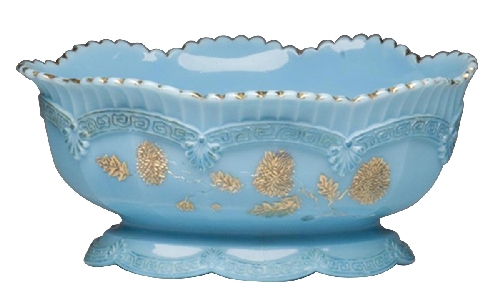True custard glass will glow in black light
Custard glass usually is the color of egg custard, but collectors have added to the definition and now identify some glass as blue custard, custard with nutmeg stain and custard with painted roses or other decorations.
The original catalogs from the companies that made custard glass called it Ivorina Verde (Heisey), Ivory decorated (Jefferson Glass Co.) or ivory and gold (Northwood Glass Co.). But it is difficult to tell real custard glass from glass of a similar color.
Original custard glass was made in England about 1880. Most of the pieces were mugs, drinking glasses or novelties -- small pieces like toothpick holders or match holders. Many pieces were made to be souvenirs, so event or town names were added to the decoration. It was not until the 1890s that custard was made by Northwood Glass Co. of Indiana, Pa., the first maker in the United States.
Northwood made some of the famous patterns collectors prefer today, including Inverted Fan & Feather and Chrysanthemum Sprig. The company used hand-painting, stains and gilding, and even produced "blue custard," which was made using a different glass formula. At least 10 other companies made custard glass before 1930, and a few are making it today.
It is easy to tell if any cream-colored glass you come across really is genuine custard glass. Get a black light, shine it on the glass and look for the luminous glow caused by the uranium in real custard glass. A Geiger counter will click near real custard glass. But don't worry. Little uranium was used, so the glass is not dangerous.
Q: I bought a baby doll in the early 1960s from an antiques store in California. The doll's head is porcelain and her body cloth. Her closed mouth is set in a slight frown. There's a copyright symbol on her neck followed by the words, "by E.I. Horsman Co., Inc., made in Germany." What is she worth today?
A: The mark on your doll is a clue to your doll's identity. She's Horsman's "Tynie Baby," one of the company's most popular dolls.
Tynie Baby was made with a porcelain head and cloth body, like your doll, or with a composition head and cloth body. She also came in a smaller all-porcelain version, and in 1950 was made in vinyl.
Your porcelain-head doll is the most valuable of the Tynie Baby dolls and in perfect condition can sell for more than $650.
E.I. Horsman Co. was founded in New York City in 1865. The company manufactured dolls, but also imported French dolls and German dolls. Yours was made in Germany.
Q: Sixty-five years ago, when my family would visit my grandmother, it would be such a treat to get to use one of the teaspoons hanging from the rack around her silver sugar bowl. The large bowl with its attached 12-spoon rack always sat in the center of her dining table. The mark on each spoon is "1835 R. Wallace 6." Can you tell me something about its age and maker?
A: Your grandmother's combination sugar bowl and spoon rack was made by R. Wallace & Sons Manufacturing Co., which was in business under that name in Wallingford, Conn., from 1871 until 1956. The mark indicates that the set is "triple plate" -- triple-plated silver.
Combination sugar bowls and spoon racks were first made in the United States in 1874. They're favorites among spoon collectors and were made by many American silver companies until the 1920s.
Q: Some tiles we found in a chicken coop near a Victorian house we just bought are marked "Providential Tile Works, Trenton, New Jersey." The horizontal tile shows a dog chasing a buck in the woods. Two long vertical tiles picture hunters. The set of 10 tiles can be put together to make a fireplace surround. What are they worth?
A: The Providential Tile Works of Trenton, N.J., operated from 1885 to 1913. It made many different glazed tiles with decorations that were either flat or in relief. It is difficult to find an old fireplace surround, so your tiles could sell for as much as $750 to someone who needs the set.
Q: Is it safe to wear cloisonne jewelry or even to keep cloisonne pieces in the house? I was told cloisonne is radioactive.
A: Cloisonne does not present a radiation problem. Although pieces may make a Geiger counter click, the radiation is very small. It comes from the color used in the enamel. You'll get more radiation exposure from a smoke detector or some kinds of red brick.
Terry Kovel's column is syndicated by King Features. Write to: Kovels, (Las Vegas Review-Journal), King Features Syndicate, 300 W. 57th St., New York, NY 10019.

















